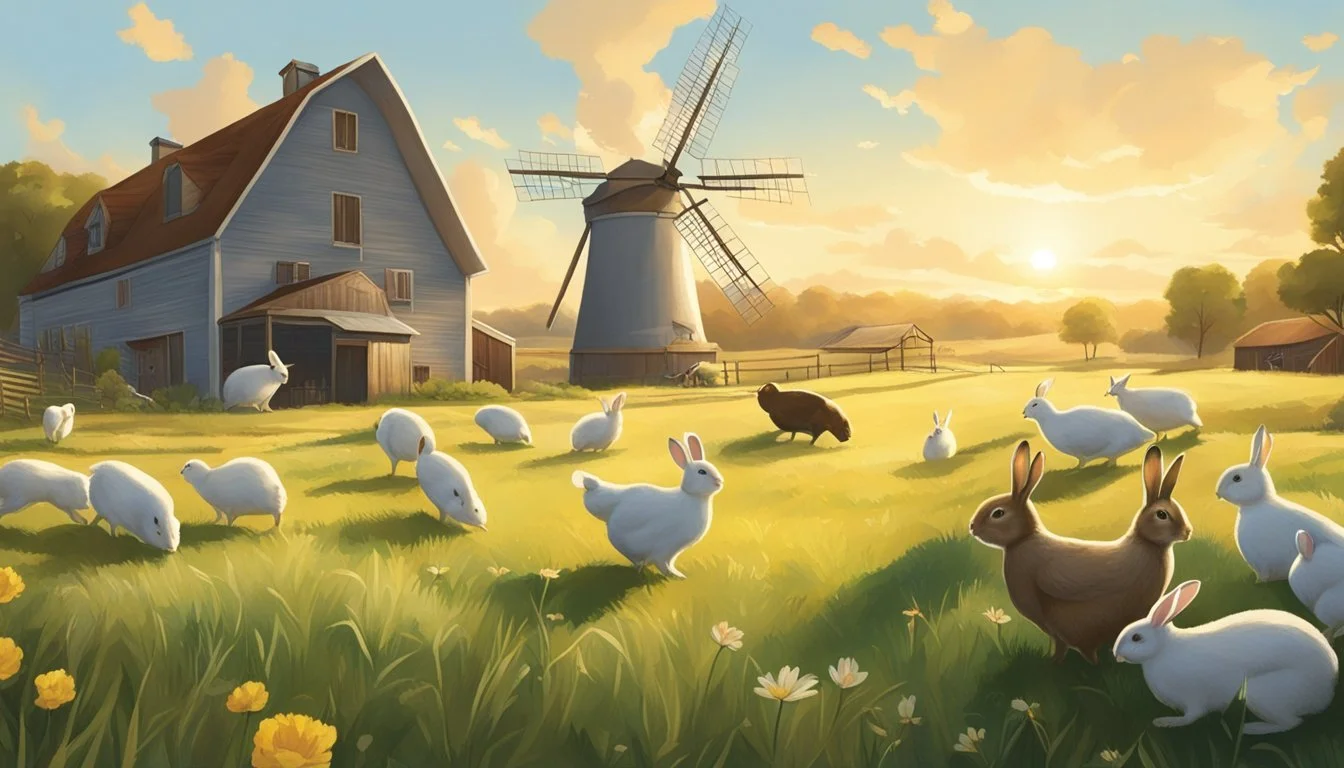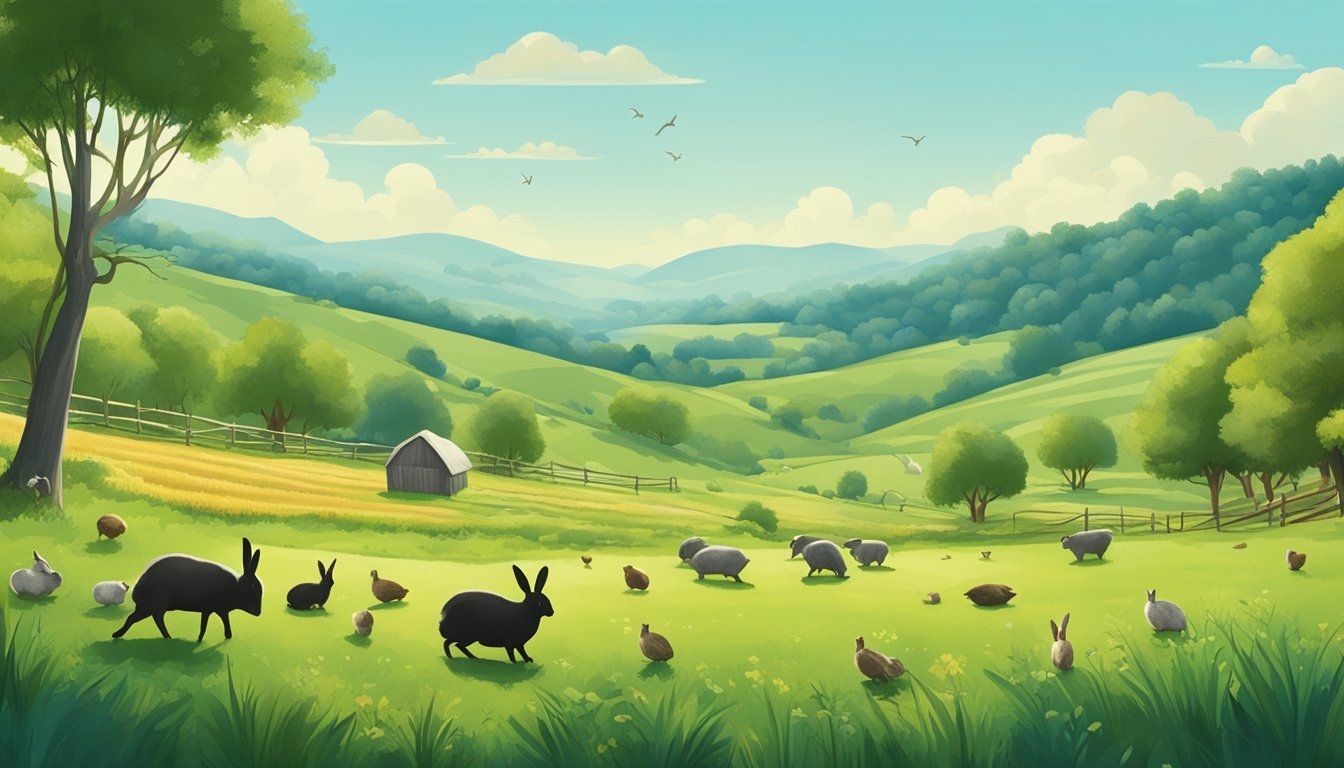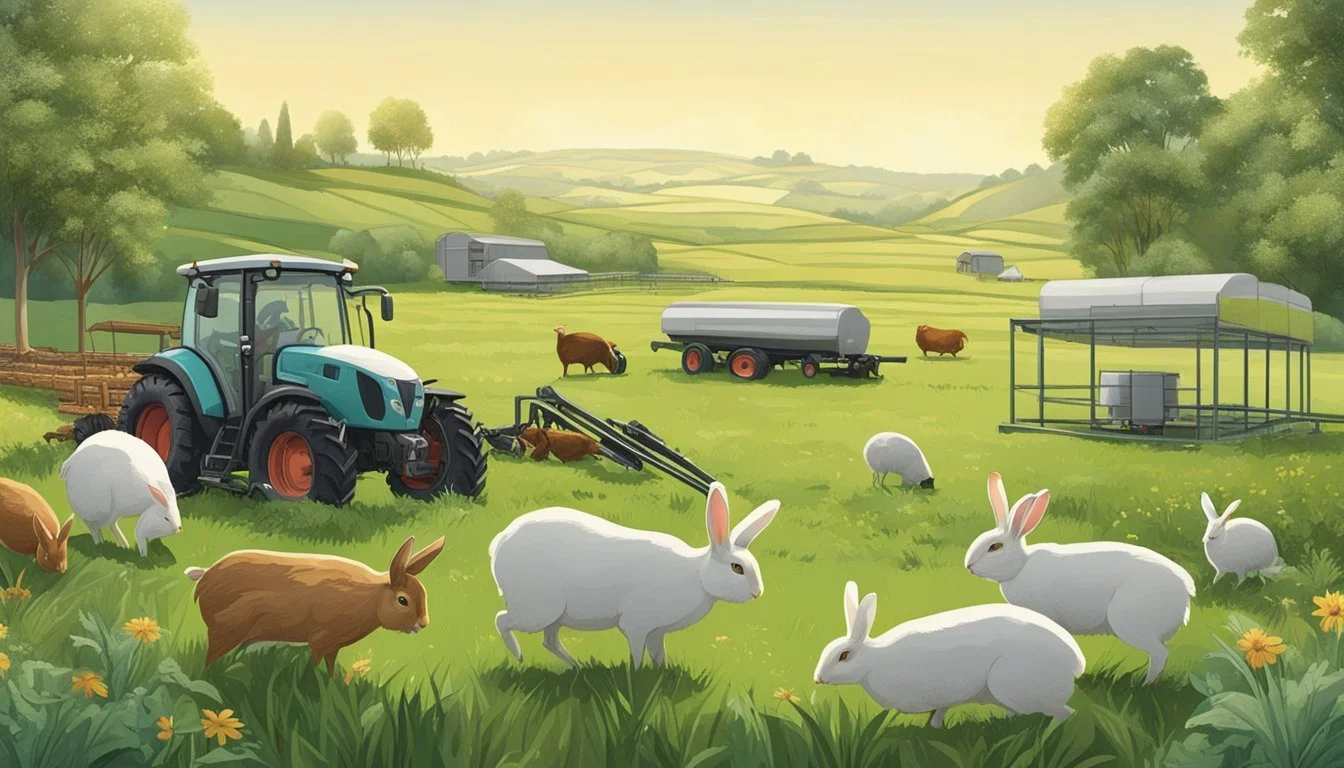Sustainable Meat Production
How Rabbits, Poultry, and Alternative Livestock Are Shaping the Future
Sustainable meat production has become a focal point in discussions about agriculture and environmental sustainability. It is seen as a critical component of sustainable development, offering pathways to improved food security while minimizing the ecological footprint associated with traditional livestock farming. The pursuit of sustainable meat production involves a wide array of practices, designed to reduce resource inputs, enhance animal welfare, and reduce pollution and waste.
Rabbits are increasingly recognized as a valuable source for sustainable meat due to their reproductive efficiency and the relatively small ecological impact of their production. With their high-protein, low-fat meat, rabbits can contribute to a balanced diet while requiring less feed and space compared to traditional livestock. Their manure is also a valuable by-product, contributing to soil health and reducing the need for chemical fertilizers. Similarly, poultry production presents opportunities for sustainability, with practices such as rotational grazing and the use of heritage breeds playing a role in creating resilient agricultural systems.
Moreover, innovative approaches are continually being integrated into meat production to further promote sustainability. These include precision agriculture techniques, improved animal feed formulations, and waste reduction strategies. Each innovation aligns with the principles of sustainability, aiming to meet current needs without compromising the ability of future generations to meet their own, thereby ensuring ongoing food security and protection of the environment.
An Overview of Sustainable Meat Production
Sustainable meat production is an essential component of a responsible agricultural sector, focusing on preserving the environment while ensuring animal welfare and meeting the global demand for meat.
The Importance of Sustainability in Agriculture
Sustainable agriculture aims to meet society's food and textile needs in the present without compromising the ability of future generations to meet their own needs. In the context of meat production, this involves practices that minimize environmental impact, reduce greenhouse gas emissions, and maintain biodiversity. Rabbits and poultry are often highlighted as sustainable options due to their efficient feed conversion rates and lower carbon footprints compared to traditional livestock. Nevertheless, sustainability also entails ethical animal husbandry and addressing the broader implications on global warming and deforestation.
Challenges in Current Meat Production Practices
Current meat production practices are fraught with challenges that undermine sustainability. The industry is a significant contributor to greenhouse gas emissions, which exacerbate global warming, and it's often implicated in deforestation, especially in the case of cattle ranching. Another pressing concern is pollution, with animal waste and agricultural runoff leading to eutrophication of water bodies. Addressing these issues requires innovations in farming practices, improvement in waste management, and a shift towards production methods that have a lower overall impact on the planet.
Rabbit Farming: An Untapped Potential
Rabbit farming presents a significant opportunity for sustainable meat production, offering a resource-efficient source of protein with a low environmental footprint and favorable economic potential.
Benefits of Rabbit Meat Production
Rabbit farming is celebrated for its high feed conversion efficiency; rabbits convert feed into protein more efficiently than many other animals. They require less feed per kilogram of meat produced, helping reduce the demand on feed mills and overall feed costs. This aspect alone makes rabbit meat production a viable option for small and large producers alike.
The practice supports rural economies, providing economic opportunities with comparatively low starting costs. Given the right conditions, mortality rates can be kept low, and growth rates can be optimized, further enhancing productivity.
Nutritional Features of Rabbit Meat
Rabbit meat stands out for its excellent nutritional profile: it is high in protein and low in fat. Notably, it has a low-fat content, with a high percentage of unsaturated fatty acids, making it a healthier alternative to other meats. Furthermore, it boasts a low cholesterol level, contributing to its positioning as a heart-healthy option.
These nutritional features indicate that rabbit meat could be marketed as a premium, health-conscious choice for consumers, particularly in markets where dietary health is a growing concern.
Rabbit Breeds for Meat Production
Among the various breeds suitable for meat production, the New Zealand White is a standout for its growth rate and meat quality. This breed is known for its robustness and adaptability, which contribute to its popularity and widespread use in the industry. Different breeds can be selected based on regional climate conditions, desired carcass characteristics, and other specific farmer requirements.
Economic and Environmental Impacts
The economic advantages of rabbit farming are manifold. With efficient protein transformation, it provides a cost-effective option for meat production. Unlike ruminant livestock, rabbits produce less methane, making their environmental impact lower compared to larger meat animals.
Their feed efficiency can be further improved by integrating alternative protein feeds, reducing reliance on traditional, costlier feed ingredients. This not only ensures a more sustainable farming practice but also reduces the environmental burden of production.
In conclusion, rabbit farming for meat provides an untapped potential in sustainable agriculture, offering compelling benefits in efficiency, nutrition, and economic viability, particularly for smallholder farms and developing economies.
Poultry Production Insights
Poultry production has emerged as a key player in the quest for sustainable meat, promising both economic gain and challenges in ethical practices. Efforts to maintain balance between rapid growth and sustainability are critical for future success.
Prospects of Poultry as Sustainable Meat
Poultry, particularly chickens and ducks, has rapidly become one of the most dominant forms of livestock bred for meat and eggs across the globe. The Food and Agriculture Organization (FAO) cites poultry's impressive growth rate and adaptability to varied environments as key advantages. This growth reflects a potential for poultry to be a sustainable source of protein, considering its relatively low carbon footprint and efficient feed conversion rates compared to other livestock.
Economic Benefits of Poultry Farming
The economic prospects of poultry farming are substantial, especially given its low barrier to entry. Small and large-scale operations alike contribute significantly to the economies of both developing and developed countries, with the United States leading in poultry production technology and outputs. The industry supports numerous jobs, from on-farm labor to the provision of related goods and services, like feed production and veterinary care. The adaptability of poultry farming allows for diverse economic opportunities, which can lead to increased economic prosperity and support the United Nations Sustainable Development goals.
Addressing Ethical Concerns
Despite its benefits, poultry production does not come without its challenges. Ethical concerns, including animal welfare and sourcing practices, have garnered attention. Producers are increasingly expected to mitigate these concerns by implementing humane practices, reducing antibiotic use, and ensuring the health and welfare of their flocks. Businesses that prioritize these ethical considerations are more inclined to gain favor with a consumer base that is increasingly conscious of animal welfare and the social impact of their purchasing decisions. Addressing these concerns is not only a moral imperative but could also be seen as an economic investment in maintaining consumer trust and market stability.
Marketing and Consumer Dynamics
Exploring consumer preferences and the strategic role of marketing is essential to understand the framework of sustainable meat production. These factors directly influence production trends and market dynamics, especially within the context of rabbits and poultry.
Understanding Consumers’ Preferences
Consumers’ preferences play a crucial role in shaping the sustainable meat market. Studies have indicated that rabbit meat is perceived favorably for its nutritional value, being low in fat and cholesterol. This recognition is paramount in driving demand, particularly amongst health-conscious consumers. In France, a nation with a rich culinary tradition, rabbit meat is appreciated not just for its flavor but as part of the rural economy. The attitudes of consumers towards meat consumption are often influenced by factors like taste, price, health benefits, and environmental impact. Large corporations and beef purchasers monitor these preferences closely to adjust their supply chains and marketing strategies effectively, ensuring alignment with consumer expectations.
The Role of Marketing in Sustainable Meat Promotion
Marketing is instrumental in informing and educating the public about the benefits of sustainable meat options. By highlighting key attributes such as the environmentally friendly aspects of rabbit meat production or the health benefits of consuming poultry, marketing campaigns can shift consumer attitudes towards these meats. Effective marketing strategies often include clear messaging about the product's origin, sustainability credentials, and nutritional information, which resonates well with today's ethically conscious consumers. Additionally, in the promotion of sustainable meats, the implications for the rural economy are often used as a marketing tool to appeal to consumers’ preference for supporting local farmers and transparent supply chains.
Innovations and Future Directions in Meat Production
As the global population continues to grow, the need for innovative approaches to meet the demand for meat without compromising sustainability is crucial. Technological advancements and policy reforms are set to play a significant role in shaping the future of meat production.
Alternative Feeds and Improved Feed Efficiency
Soybean meal, a common component of animal feeds, is being reconsidered in favor of alternative feed options that can improve feed efficiency and reduce environmental impact. Researchers are exploring locally sourced and less resource-intensive feed ingredients, such as insects and algae, which have shown promise in reducing dependency on traditional feeds. Improvements in feed efficiency directly contribute to a sustainable global food system, aligning with the goals outlined by the FAO.
Policy, Regulation, and Industry Initiatives
The role of policymakers and regulations cannot be overstated in the transition toward sustainable meat production. There is a movement toward stringent regulations that promote traceability and sustainability within the meat production industry. After the COVID-19 pandemic, there has been a heightened focus on the resilience of the global food system, with industry initiatives increasingly striving to align with new regulations to ensure both food security and sustainability.
The Role of Small-Scale Producers
Small-scale producers serve an integral role in sustainable meat production, creating economic and social benefits for rural communities. They often adopt ethical practices that align with increasing consumer demand for responsibly sourced products.
Supporting Local Farmers and Rural Economies
Small-scale farmers are vital in maintaining the vitality of the rural economy. By producing meats such as rabbit and poultry, these farmers support the local financial landscape in several ways. They employ residents, keep profits within the community, and contribute to the sustainability of local agriculture. For example, the sale of rabbit meat, which is high in protein and low in fat, provides a source of healthful food while also reinforcing the local economy.
Challenges and Opportunities for Small-Scale Farmers
While small-scale farmers make significant contributions, they encounter several challenges, including limited access to markets, high costs of environmentally sustainable practices, and competing with large-scale producers. Nonetheless, opportunities abound. These producers can exploit niche markets, where unique and high-quality meats, such as those from free-range poultry, are often sought after. Additionally, programs aimed at supporting small-scale livestock production can provide them with valuable information and resources to improve their operations. The dynamic between overcoming these challenges and seizing opportunities defines the resilience and potential growth of small-scale farmers.
Health and Dietary Considerations
In considering sustainable meat production, health and dietary considerations are paramount. Examining how meat consumption affects public health and the emergence of health-conscious meat choices can illuminate the role of alternative meats such as rabbit in a balanced diet.
Meat Consumption and Public Health
Public health is significantly influenced by diet, particularly meat consumption. Meat is a primary source of protein and other essential nutrients, but its impact on health can vary. For instance, high consumption of red and processed meats is often associated with increased risks of obesity, hypertension, diabetes, and cardiovascular disease. On the other hand, meats with high protein content and low-fat content can be beneficial to health, especially when it includes a higher proportion of unsaturated fatty acids and lower levels of cholesterol.
Shifting Towards Health-Conscious Meat Choices
The trend of selecting healthier meat options is gaining ground as consumers become more aware of the link between diet and chronic diseases. Choices are increasingly based on meat's nutritional profile, with a preference for options that contribute to food security and have positive health attributes. For example, the inclusion of rabbit meat in diets has been noted for its low cholesterol and low sodium levels, making it a potentially healthier alternative for those managing diabetes or cardiovascular health concerns.






